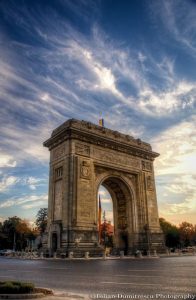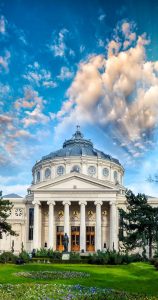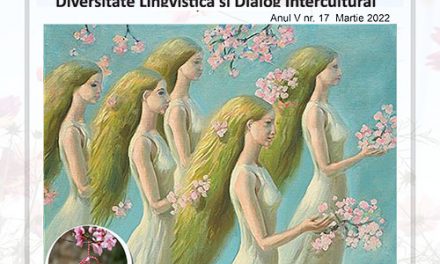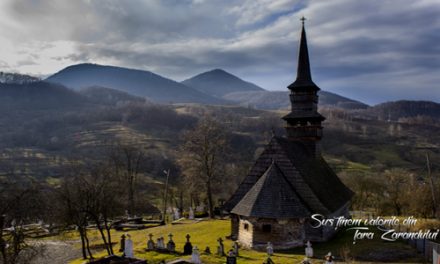Bucarest – The Metropole
 The Romanian Capital, Bucharest, has been in continuous transformation ever since. As a consequence, The Little Paris, as it used to be called this metropole, due to its chariots and cars de la belle epoque, Bucharest has become nowadays a modern city with a great population and vehicles flow, so that it is hard to recognize any landmarks of the past epoque, the modernism engulfing almost everything.
The Romanian Capital, Bucharest, has been in continuous transformation ever since. As a consequence, The Little Paris, as it used to be called this metropole, due to its chariots and cars de la belle epoque, Bucharest has become nowadays a modern city with a great population and vehicles flow, so that it is hard to recognize any landmarks of the past epoque, the modernism engulfing almost everything.
But what is still remarkable, comparing to other capitals of the world, is that Bucharest remains a citadel of eviable green places. Being crossed by two rivers, Dâmboviţa şi Colentina, Bucharest is naturally decorated with a bunch of lakes, beautifully arranged to serve as estival leisure spaces, being provided with rowing and little steam boats, places where not only the locals but tourists from everywhere can get rid of the mumble and jumble of the capital and get some peaceful and agreeable refuge.
On the Colentina River, there are several lakes: Herastrau, Floreasca, Tei and Colentina, each of them surrounded by parks full of trees and decorated alleys all through, like a green labirynth, adorned with season flowers.
To this patrimony of green spaces, Bucharest adds some other parks, such as: Cismigiu, Tineretului (NT:The Youth Park), Alexandru Ioan Cuza, Carol and last, but not least, Botanical Garden, the biggest in Romania.
 Bucharest also offers the Romanian and foreign tourist historical monuments, museums, theatres, art galeries and cultural institutions, among which I would like to point out: The University of Bucharest, The Intercontinental Hotel, Victoria Palace, The Romanian Atheneum, The Art Museum, The Romanian National Museum, The Romanian Opera, The National Theatre, The Romanian Patriarchy, The Village Museum, The Triumphal Arc, The State Circus and so on. Besides, the tourist can admire the splashing fountains in the middle of magnificent flower beds, on his way across the Dambovita River Bridges, or can simply go to outstanding opera and operetta concerts, to see a play at the teatre, or to get accommodation at luxury hotels.
Bucharest also offers the Romanian and foreign tourist historical monuments, museums, theatres, art galeries and cultural institutions, among which I would like to point out: The University of Bucharest, The Intercontinental Hotel, Victoria Palace, The Romanian Atheneum, The Art Museum, The Romanian National Museum, The Romanian Opera, The National Theatre, The Romanian Patriarchy, The Village Museum, The Triumphal Arc, The State Circus and so on. Besides, the tourist can admire the splashing fountains in the middle of magnificent flower beds, on his way across the Dambovita River Bridges, or can simply go to outstanding opera and operetta concerts, to see a play at the teatre, or to get accommodation at luxury hotels.
And, of course, nobody shouldn´t miss the opportunity to visit Casa Poporului (The House of People), presently, the building is The Romanian Parliament House, a grand construction, combining several architectural styles.
This is recognized as the second largest administrative building in the world, after the US Pentagon, and the first as volume, surpassing even the Keops’s pyramid. It was built at the order of Nicolae Ceausescu, the president of the Socialist Republic of Romania.
 For the future, the authorities’ attention is focused on But the capital of Romania gives the visitor a special show through the underground network of the subway, one of the most important achievements of the last four decades, a work mainly carried out before the Revolution of 1989. At the outskirts of the capital city, there are two international airports: Henri Coanda, former Otopeni, and Aurel Vlaicu, former Baneasa, and North Railway Station also, which is the main railway junction with ramifications throughout the country.the realization of the Danube-Bucharest Canal. Two important highways start also from Bucharest: one to Piteşti and another one to Constanţa.
For the future, the authorities’ attention is focused on But the capital of Romania gives the visitor a special show through the underground network of the subway, one of the most important achievements of the last four decades, a work mainly carried out before the Revolution of 1989. At the outskirts of the capital city, there are two international airports: Henri Coanda, former Otopeni, and Aurel Vlaicu, former Baneasa, and North Railway Station also, which is the main railway junction with ramifications throughout the country.the realization of the Danube-Bucharest Canal. Two important highways start also from Bucharest: one to Piteşti and another one to Constanţa.
At present, Bucharest is the most important industrial and commercial center in Romania, as well as an educational one. There are thousands of Romanian and foreign students studying in the faculties of the State University or institutes. In general, Bucharest people prefer to spend their holidays and weekends on the Prahova Valley, Predeal or Poiana Brasov, no matter the season, but during the summer they literally invade the Romanian seaside with its range of famous resorts.
București – Metropola
 Bucureşti, capitala României, a fost şi este în continuă schimbare. De la metropola cu trăsuri şi maşini de epocă, care cândva era alintată cu numele de „Micul Paris”, a ajuns, în zilele noastre, un oraş modern cu un mare aflux de populaţie, dar şi de autovehicule. Centrul istoric abia mai păstrează amintirile din epoca trecută, modernismul acaparând aproape totul. Ceea ce este de remarcat, în comparaţie cu alte capitale ale lumii, Bucureştiul rămâne o citadelă cu spaţii verzi de invidiat. El este străbătut de două râuri, Dâmboviţa şi Colentina, cu un şirag de lacuri amenajate pentru agrement în perioada estivală cu ştranduri, bărci şi vaporaşe, înconjurate de parcuri unde atât localnicii cât şi turiştii se refugiază în linişte de tumultul citadin. Pe râul Colentina se desfăşoară lacurile Herăstrău, Floreasca, Tei şi Colentina, fiecare dintre ele fiind înconjurate de parcuri împodobite cu arbori, alei ce le străbat de la un capăt la altul ca un adevărat labirint şi spaţii verzi cu flori de sezon. La patrimoniul spaţiilor verzi, se mai adaugă parcurile: Cişmigiu, Tineretului, Alexandru Ioan Cuza, Carol şi, nu în ultimul rând,Grădina Botanică, cea mai mare din ţară. Bucureştiul oferă turistului român şi străin monumente istorice, muzee, teatre, instituţii de artă şi cultură, printre care aş evidenţia: Universitatea, Hotelul Intercontinental, Palatul Victoria, Sala Palatului, Atheneul Român, Muzeul de Artă, Muzeul României, Opera Română, Teatrul Naţional, Patriarhia Română, Muzeul Satului, Arcul de Triumf, Circul de Stat etc.
Bucureşti, capitala României, a fost şi este în continuă schimbare. De la metropola cu trăsuri şi maşini de epocă, care cândva era alintată cu numele de „Micul Paris”, a ajuns, în zilele noastre, un oraş modern cu un mare aflux de populaţie, dar şi de autovehicule. Centrul istoric abia mai păstrează amintirile din epoca trecută, modernismul acaparând aproape totul. Ceea ce este de remarcat, în comparaţie cu alte capitale ale lumii, Bucureştiul rămâne o citadelă cu spaţii verzi de invidiat. El este străbătut de două râuri, Dâmboviţa şi Colentina, cu un şirag de lacuri amenajate pentru agrement în perioada estivală cu ştranduri, bărci şi vaporaşe, înconjurate de parcuri unde atât localnicii cât şi turiştii se refugiază în linişte de tumultul citadin. Pe râul Colentina se desfăşoară lacurile Herăstrău, Floreasca, Tei şi Colentina, fiecare dintre ele fiind înconjurate de parcuri împodobite cu arbori, alei ce le străbat de la un capăt la altul ca un adevărat labirint şi spaţii verzi cu flori de sezon. La patrimoniul spaţiilor verzi, se mai adaugă parcurile: Cişmigiu, Tineretului, Alexandru Ioan Cuza, Carol şi, nu în ultimul rând,Grădina Botanică, cea mai mare din ţară. Bucureştiul oferă turistului român şi străin monumente istorice, muzee, teatre, instituţii de artă şi cultură, printre care aş evidenţia: Universitatea, Hotelul Intercontinental, Palatul Victoria, Sala Palatului, Atheneul Român, Muzeul de Artă, Muzeul României, Opera Română, Teatrul Naţional, Patriarhia Română, Muzeul Satului, Arcul de Triumf, Circul de Stat etc.
 Turistul are posibilitatea să admire numeroasele fântâni arteziene şi florile din spaţiile verzi, să treacă podurile peste Dâmboviţa, să meargă la spectacolele de la operă, operetă sau teatru, să fie cazat la hoteluri de lux. Şi, nu în ultimă instanţă, are ocazia să admire Casa Poporului (Parlamentului României), o clădire măreaţă, în care sunt îmbinate stiluri de arhitectură din Occident şi Orient. Aceasta este recunoscută ca a doua mare construcţie administrativă din lume, după Pentagonul din SUA şi prima ca volum, întrecând chiar piramida lui Keops. Ea a fost construită din ordinul și pe timpul lui Nicolae Ceaușescu, ultimul președinte al Republicii Socialiste România.
Turistul are posibilitatea să admire numeroasele fântâni arteziene şi florile din spaţiile verzi, să treacă podurile peste Dâmboviţa, să meargă la spectacolele de la operă, operetă sau teatru, să fie cazat la hoteluri de lux. Şi, nu în ultimă instanţă, are ocazia să admire Casa Poporului (Parlamentului României), o clădire măreaţă, în care sunt îmbinate stiluri de arhitectură din Occident şi Orient. Aceasta este recunoscută ca a doua mare construcţie administrativă din lume, după Pentagonul din SUA şi prima ca volum, întrecând chiar piramida lui Keops. Ea a fost construită din ordinul și pe timpul lui Nicolae Ceaușescu, ultimul președinte al Republicii Socialiste România.
Dar capitala României îi oferă vizitatorului un spectacol deosebit şi prin reţeaua subterană a metroului, una din realizările cele mai importante din ultimele patru decenii, lucrare realizată, în mare parte, înainte de Revoluția din 1989.
 La marginea capitalei se află două aeroporturi internaţionale: Henri Coandă (fost Otopeni) şi Aurel Vlaicu (fost Băneasa). De asemenea, Gara de Nord este principalul nod feroviar cu ramificaţii în întreaga ţară. Pentru viitor, în atenţia autorităţilor, este realizarea Canalului Dunăre-Bucureşti.
La marginea capitalei se află două aeroporturi internaţionale: Henri Coandă (fost Otopeni) şi Aurel Vlaicu (fost Băneasa). De asemenea, Gara de Nord este principalul nod feroviar cu ramificaţii în întreaga ţară. Pentru viitor, în atenţia autorităţilor, este realizarea Canalului Dunăre-Bucureşti.
Tot din Bucureşti, pornesc două autostrăzi importante: una spre Piteşti şi alta spre Constanţa.
La ora actuală, Bucureştiul este cel mai important centru industrial şi comercial din România, dar şi de învăţământ. În facultăţile Universităţii sau al institutelor, studiază mii de studenţi români şi străini.
În general, bucureştenii preferă să-şi petreacă vacanţele şi weekend-ul pe Valea Prahovei, Predeal sau Poiana Braşov, în orice anotimp, iar în perioada estivală invadează litoralul românesc cu salba sa de staţiuni…
Ion Nălbitoru (română) și Lia Nenciu (engleză) –ROMANIA, THE CATHEDRAL OF THE CARPATHIANS (ROMÂNIA, CATEDRALA DIN CARPAŢI) – Tourist reports – (Reportaje turistice) Editura BIBLIOSTAR Rm. Vâlcea, 2018






